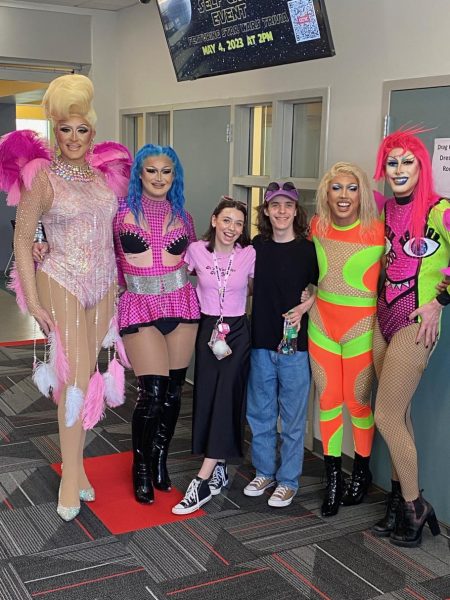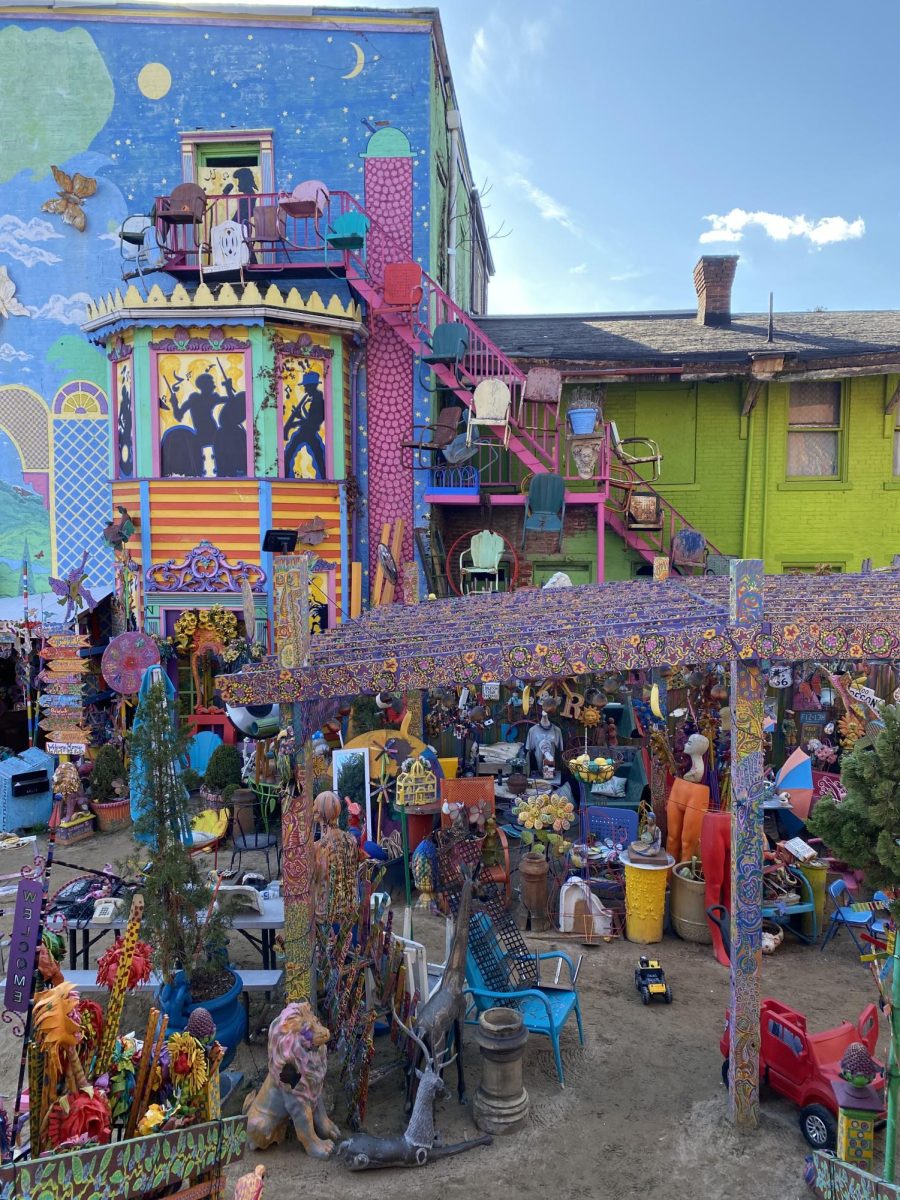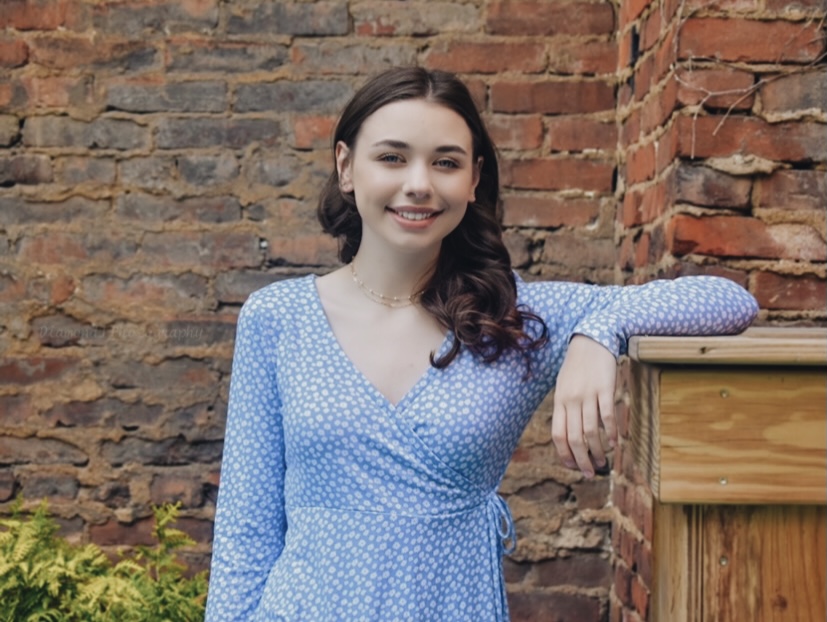
On April 21st, 2023, the Community College of Allegheny County held its second annual Drag Show event on their Allegheny campus, free to their students and the public. The event is held in memory and celebration of CCAC professor, Sandy Callan, who passed away early January of 2022. Fellow CCAC professor, Bobby Ficco, and head of Student Life, Christine McQuaide, organized the Drag Show event last spring following Sandy’s unexpected death. The Drag Show event is held to raise money for a student opportunity scholarship in Sandy’s name.
Bobby Ficco explains, “Through our educational foundation, the college will start what they call an ‘endowed’ scholarship. You have to reach $10,000 in three years’ time, but then at that point, you have a scholarship. Every year will give us $400 that we can give as a scholarship to a student.” He says that they were able to raise $6,000 last year but is not sure how much they have raised this year yet. Ficco explains how he produced the idea to raise money for this scholarship through hosting a cookout with a Drag show. He says, “I knew that the chair of our culinary program was very close with Sandy, so I knew that he would be more than happy to jump in and help.” Ficco is also in a long-term relationship with one of the event’s Drag Queen performers, JT, or Mirage (in Drag), who is a close friend to three of Pittsburgh’s most successful Drag Queens – Calipso, Indie Skies, and Luna Skies.
When I asked Ficco why he felt so passionate about organizing an event in memory of Sandy Callan, he explained to me that when Sandy died, his “heart was missing a piece.” He explains how Sandy was his biggest cheerleader when he started working at CCAC part-time in 2013, then getting promoted to a full-time position teaching at the community college in 2019. Sandy was a part of Ficco’s hiring committee and was constantly reminding Bobby how proud he made her, saying randomly at times, “Bobby, I am so proud of you because exactly what you said you were going to do, you went out there and did.”
Ficco says, “She was not just a friend or a colleague, she was like my mom. I saw her every day, day in and day out. I always felt so comfortable sharing everything and anything about my life because she was so loving and so caring to every respect. We had very long, in depth conversations, one minute was really half an hour or an hour.” Sandy was fully accepting of Bobby as an openly gay man, frequently asking about his partner, JT. Ficco says, “She never made me feel any different, not only beyond making you not feel different, she was so inclusive. It wasn’t like she even censored out part of it. She was always just very open, very accepting.”
Sandy Callan showed love and acceptance to every person she came across throughout her 35 years working at CCAC. That was another reason that drove Bobby’s efforts to organize a memorial event in honor of Sandy. According to Ficco, “Everyone at the college knew her to some capacity, to some respect.” Ficco explains that Sandy was heavily involved with the college in teaching classes, she was the lab tech, she was part of the assessment committee, and she was involved with the Dean’s. He says, “Her presence was among everybody at that school.”
They all felt the love and joy that inevitably followed Sandy until she died unexpectedly of a heart attack at age 72.
Ficco explains the complex, strained relationships he holds with his biological parents. His father has been emotionally abusive towards him since he was a child, and his mother has developed Alzheimer’s disease. Losing Sandy truly was like losing a parent to him, which made it even harder for Bobby to cope. He says, “That’s what made Sandy even more of a mother to me. She was still completely mentally cognizant. I was able to speak to her about my personal life and she could offer me solid advice. That’s what made losing her all the more difficult.”
RuPaul, also known as America’s, most successful Drag Queen, famously says “As gay people, we get to choose our family.” This theme held especially true throughout my conversations with the queens at the event about their own biological families, their experiences growing up as queer children, their feelings about the recent attacks made towards the LGBTQ+ community, and their newfound relationships through the Drag community in Pittsburgh.
Pittsburgh’s 25-year-old queen, Calipso, moved to Bloomfield last year, but has been doing drag for almost 5 years now. She tells me, “My family doesn’t know I do Drag. When I say, ‘they don’t know’ it’s because I have not told them, but I think they really do know, they just don’t want to address it.” Her family currently lives back in Venezuela, where Calipso is originally from. I asked Calipso what her family thinks she does for a profession, and she says, “Honestly, I don’t know” and laughs with the most contagious laughter that fills up the room. She goes on to say, “When I came out to them as a gay man, they didn’t take it very well. They stopped talking to me for almost 6 months. I think when they find out [about] the Drag, it’s going to be the same thing. Maybe not. When I tell you it has saved my life, it has pulled me out of depression –it is what I love. It gets me up every morning.” And the work is tough. Calipso
performed in the 80-degree weather, wearing a piece she handmade. The garment was a full body suit exposing one leg, with a hat attached to give an illusion of a sunhat. It was dark purple and fully made of sequins. I loved it and wanted one of my own immediately. It looked like an outfit I would see on Jessica Rabbit, probably the most iconic cartoon character in American television that emulates a Drag Queen.
Calipso says that she is most inspired by her friends, Indie, and Luna, who perform alongside her every weekend. She says, “It’s always something new. I feel like they feel the same way about me, they take stuff from me, and I take stuff from them. Especially for Indie who has been doing drag for so many years.” And for someone like Calipso, a 20-something year old career girl with a family who lives on another continent, this family that she’s built from her hard-working career in Drag is everything to her. Like Bobby, Calipso has lost a sense of her own true family and has begun finding that love again throughout her relationship with Drag. Along with being the happiest she’s ever been, she is incredibly successful, especially in Pittsburgh. Calipso says, “I have been to Baltimore, I have been to Ohio, I’ve been to Virginia, and when I tell you, the crowd in Pittsburgh is like no one else. Nowhere else. Pittsburgh LOVES drag queens.”
Indie Skies seems like a Drag mother to Calipso – answering her questions about the profession, inviting her to shows, and loving her for who she truly is. Indie Skies grew up in the conservative state of Utah but moved to Pittsburgh in 2019 for her job as a retail associate after being laid off during the COVID-19 pandemic, alongside Luna Skies. In 2020, the two decided to start doing Drag show events full time, and eventually developed a long-term relationship. Indie’s family was very accepting and encouraging of her discovering her queer identity as a child. She says, “Growing up, I was a very feminine kid. I was sensitive, soft spoken, but I loved
Barbies. I loved wearing heels and running in my mom’s clothes. I was just very, very gay the whole time.” She is the tallest Queen of the group, and her energetic presence reflects that amongst the four girls.
Her family’s acceptance was fortunate, and rare in the place where Indie was raised. Indie explains, “Because I’m part Native American, part of the culture is allowing your children and being a guide to show them what they are interested in and how to be the best thing that they are interested in being. It wasn’t easy because it’s very religious, but they did their best.” She describes her hometown in Utah, saying, “A lot of kids end up homeless. They get kicked out of their houses, so I was fortunate. My mom said that she always knew that I was different, or that I may have a different path than everybody else.” Indie’s path was one covered in hot pink glitter and feather boas. She tells me about her love for pageant competitions and making her own outfits to wear, pointing to the one she just changed out of – a dress covered in baby pink feathers, large rhinestones, and pearls hanging off the sides, almost like they were dripping from her.
Regarding the recent threats being made from protesters to cancel Drag shows around the country, Indie says she feels especially safe in her community here in Pittsburgh. She says, “I notice that there is a change in the environment and in society right now. But I feel safe in Pittsburgh and supported. Some of our venues, if they get calls harassing them about the event, they will just tell them flat out ‘Quit calling here or we’ll call the cops.’ It’s nice to see that people will stand up and have our backs. No one is forced to come to an event. It’s a choice.” Indie explains how Drag has ultimately shaped her as a person saying, “I’m more of a rebellious spirit. When I was quiet and shy when I was younger, that’s because I was insecure and afraid. I didn’t know myself. Now that I know myself better, I’m a lot more vocal, visible, and
unapologetic about who I am. Drag has helped me feel more empowered, but it’s also allowed me to be who I truly am.” That’s something her partner and fellow Drag Queen, Luna Skies, can also attest to.
Luna Skies is a 25-year-old queen born in Elizabeth, PA, about 45 minutes outside Pittsburgh. If you know anything about Pennsylvania, then you know that anywhere in the state outside of it’s major cities, Pittsburgh and Philidelphia, is filled with a conservative population. She describes her childhood saying, “I feel like I was a horrible kid, a horrible teenager. I didn’t like myself a lot for being queer.” She describes coming out to her parents as a challenge in itself saying, “When I came out to my parents, it was hard for them because they didn’t understand it. Now as I’m older, I realize that they just didn’t want me to live a hard life. When they were asking questions like, ‘Oh, are you sure?’ They aren’t saying it because they don’t believe me, they’re saying it because they don’t want to see me get hurt, and get bullied in school, and have to live a harder life than I have to.” It was a challenge for Luna’s parents to fully accept her being queer, but they have since come a long way. Luna says, “I don’t think that if I were not queer that my parents would ever consider going to drag shows. But I am, and they do. My dad even offers security at some of the shows when we need it, I love that.” As a teenager, lacking acceptance from her parents and community around her, Luna spent a lot of her youth trying to rebel against her parents.
Luna started doing Drag in the basement with her best friend and fellow Queen, Mirage. They spent an endless amount of time together in Mirage’s basement – watching Drag Race, smoking weed, and trying on women’s clothes. Eventually, Luna moved out to the city of Pittsburgh, where her career in Drag began to flourish. She describes her experience being laid off alongside Indie Skies, saying “The pandemic hit, we both got laid off our ‘normal’ jobs, so
we just went full steam ahead with producing shows. Then we ventured out from the bar, doing some bigger brunches. It was nice to bring in Drag shows because people wanted entertained right after the pandemic hit, and a bit during it. We were able to get into venues that were big enough, follow the regulations that they had, and build a business from there. Now we are the largest queer event production company in the tri-state area, doing lunches and shows all around.”
Their company, S&S Productions, will be hosting Pride on the Shore this year alongside some of RuPaul’s queens from Drag Race’s most recent season – season 15’s Luxx Noir London, Aura Myari, and Robyn Fierce as well as season 10’s winner – Aquaria. Luna has also worked with one of my personal favorite Drag Race Queens, Alaska Thunderfuck, winner of All Star’s season 2. Luna says, “It’s cool because some of the girls getting on [Drag Race] now are products of Drag Race. They watched Drag Race, [then] they started Drag. They’ve completely learned everything they know from Drag Race. I think that’s pretty cool.” Luna notes that her and Mirage are essentially both products of Drag Race as well.
Mirage is the 27-year-old bedroom queen who does the occasional Drag show with her friends Luna, Indie, and Calipso. Out of Drag, JT spends his days working in downtown Pittsburgh for the complaint department at PNC Bank and comes to his boyfriend, Bobby Ficco. His coworkers are extremely supportive of his Drag and loves it when he shares pictures with them from different events. Mirage says, “I actually haven’t done Drag since the last one [Drag Show memorial event held last year]. This is definitely how I prefer to spend my days, although my feet hurt at the end, it’s rewarding.”
Mirage’s performance was full of kicks, splits, jumps, and bends all while performing in platforms on concrete. She threw off her wig and threw her dollar bills into the wind as she put
on the lip sync performance of a lifetime. Mirage had been quietly preparing for this performance since the last year’s. Growing up queer, Mirage says, “I just kind of did it [Drag] secretly for a long time until I was not busted anymore. I’ve only been doing Drag publicly for 4 years, but I’ve been doing it in my bedroom for 8 years. It’s just a fun, creative outlet. It’s the same as the other girls said, it brought me out of depression. It makes you feel good about your differences.” She recalls a time where she and Luna hid in her basement bathroom once after Mirage’s father had come downstairs and saw women’s clothing laid out everywhere. Similarly, to Luna, slowly but surely, Mirage’s parents have been accepting of their son’s queer identity. Mirage says, “My family was always super supportive of my creativity, and I was always creating stuff. I’m the same as Calipso; my parents don’t know I do Drag, but I’m sure they do. They’re just happy that I’m happy.”
Mirage explains how Drag is truly just an extension of who they are and how they truly feel on the inside. She says, “It’s taking what you feel on the inside, putting that on the outside, and then sharing that with people. Sometimes it’s hard to communicate with people, so there’s other ways to do it, [like] through performing.” Mirage also explains the new-found respect for women that Drag has given her. She says, “I definitely respect women and know that it takes a lot of time [to get ready]. For me, it takes me 2 and a half hours to do my makeup. Every queen I have met really respects women because that’s what we are emulating. We love the beauty, the glam, the everything. It’s done with the utmost respect.” Mirage says her drive to do Drag comes from a place of pure self-expression, saying “I do it for myself at the end of the day. That helps me to perform for people because it’s for myself, and then there’s people that I can see care about it.” She does say, however, that she would like to spend more time doing Drag. She explains how the recent attacks on the LGBTQ+ community and Drag Queens only inspires to
publicize her Drag even more. She says, “I feel like with drag being polarizing, it’s important to be visible, do your thing, and represent for the community. It’s just focusing on the love, ignoring the hate, but educating when you can. I lost a little bit of that love, but it’s coming back.”
As far as representation for the Drag and LGBTQ+ community in Pittsburgh, things have changed a lot for Luna since moving out to the city. She says, “I grew up with some queer people around me as friends, but I think if I was younger and seeing some parents bring their teenage or younger kids to Drag shows and being around queer people, I definitely think that would’ve helped a good bit.” She goes on to say, “With Drag, it’s always a bigger picture because Drag started as a protest, regardless. But still, at the end of the day, it’s just entertainment. People will always tell you that Drag Queens are some of the nicest, comforting, loving, most open-minded, open-hearted people. You can talk to any of them because we’re all minorities. As queer people, and then as Drag Queens on top of it, we’re basically a minority in our own community as well.”
In events where they’re performing in front of children, Luna says, “A lot of times, kids don’t even know unless you make it this big, crazy thing. If we’re at an all-ages event, we’re going to be better minded of what we’re doing. If you’re taking your kid [to a Drag event] and you’re like ‘Just enjoy it, have fun!’ If they see you having fun, and other people having fun, they’re not going to question it. Half the time, people believe we’re just women. Extravagant, 7-foot-tall women with feathers. What kid doesn’t want to see someone jumping, twirling around, and whipping their hair?”
I spoke to one of the students next to me in the audience during the show about the art of Drag and why he finds it beautiful. He told me that he initially came to the event just to admire how beautiful the queens were. He compared the gracefulness in their steps to waves of water in
the ocean, natural beauty. We talked about how much joy Drag Queens brought to the community, and how heavily American culture and trends are shaped around Drag performers – from the slang we use, to the makeup techniques, and the fashion trends. So many of our most iconic singers and performers are versions of Drag Queens themselves – including Lady Gaga, Madonna, David Bowie, Freddie Mercury, and Cher, who are all frequently impersonated by Drag Queens across the world.
I mention this to the girls and utter my favorite RuPaul quote aloud, in union with Mirage – “You’re born naked, and the rest is drag.” It applies to everyone. Everyone expresses themselves specifically in a way that caters to who they are at the core in one way or another. No matter who you are. Luna says, “Everyone is a drag queen,” and she is correct. Drag is about the expression of self-love for the person you truly are, and embracing who others truly are. This, in turn, allows Drag Queens to expand their communities and families based out of pure love and their own good intentions. None of this would be possible for them without overcoming the hardships millions of queer people across the world come to face.
If everyone is a Drag queen, then Sandy Callan was a hell of a Drag queen. Sandy made people feel loved, she made sure people felt like they were acknowledged, and accepted by at least one good person in their community. She was a bright, beautiful light and soul that homed bugs of every kind after the sun went down.
That is why, at a time like this, it is crucial for us to stand up alongside our local Queens and fight for their right to be visible, despite the recent efforts of Florida Govenor, Ron DeSantis, and Tennessee Govenor, Bill Lee, to make public drag performances a misdemeanor offense and ban talk of LGBTQ+ subjects in schools. Drag Queens are fighting for more than their right to dress up as women. They are fighting to maintain the successful careers they have built and
deserve to enjoy. They are fighting for the closeted gay kids similar to who they once were. They are protecting the families they have built out of pure hard work and love. That is the epitome of the American dream, if you ask me.
From




